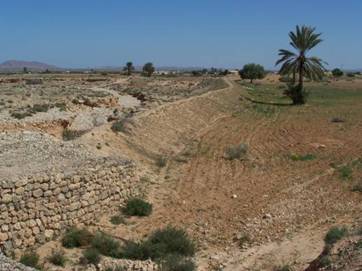Water harvesting
A wide variety of water harvesting techniques is found in the study area. In fact, the hydraulic history of this watershed is very ancient (Carton, 1888) witnessed by the remnants of a small retention dam, supposed to have been built in the Roman era, near the village of Koutine and the abandoned terraces on the mountains of wadi Nagab in addition to numerous flood spreading structures (Henchir Zitoun, Henchir Rmadi, etc....) (Ouessar et al., 2002; Ben Khehia et al., 2003; Ben Mechlia & Ouessar, 2004). The main encountered systems are: Jessour on the mountain ranges, Tabias on the foothills and piedmont areas, cisterns, and groundwater recharge gabion structures in the wadis courses. Within the framework of the national strategy for soil and water conservation, huge works have been realized between 1990 and 2000. In fact, there have been the: treatment of approximately 6500 ha in Jessour, Tabias, etc., installation of more than 175 units for groundwater recharge and flood spreading, installation of more than 10 recharge wells, and safeguard and consolidation of more than 8500 ha.

Jessour system in the mountains of Béni Khédache.

Spreading structure on the wadi Nkim.